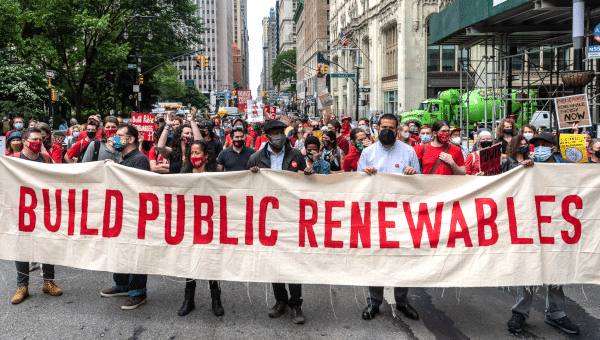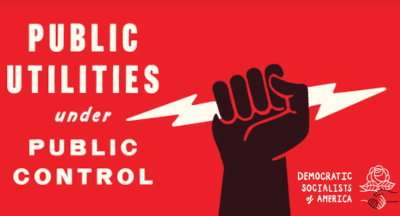On May 2, New York became the first U.S. state to pass a major Green New Deal policy following four years of organizing by the Public Power NY coalition and allies. The Build Public Renewables Act (BPRA), now New York State law, empowers and directs the state’s public power provider—the New York Power Authority (NYPA)—to plan, build, and operate renewable energy projects across New York State. Organizers are now focusing on growing the movement for Public Power from coast to coast.
Public Power NY was launched in 2019 by the Ecosocialist Working Group of the NY City’s Democratic Socialists of America (DSA). Initially against a rate hike request from the private utility ConEd, organizers consolidated the argument that New York required a strong public alternative to private utilities. Fortunately, New York already had an existing public utility that could be empowered: the New York Power Authority.
 “Ninety years ago, FDR [President Franklin Delano Roosevelt] established the New York Power Authority to create power for the people. Over the decades, FDR’s vision for NYPA has been diminished. Today we reclaim that power, ensuring NYPA serves us, and that renewable energy is a public good,” reads the Public Power NY statement on BPRA’s approval in the NY State budget.
“Ninety years ago, FDR [President Franklin Delano Roosevelt] established the New York Power Authority to create power for the people. Over the decades, FDR’s vision for NYPA has been diminished. Today we reclaim that power, ensuring NYPA serves us, and that renewable energy is a public good,” reads the Public Power NY statement on BPRA’s approval in the NY State budget.
NYPA: The Return of A New Deal Public Utility
Established during the Great Depression to counter private utilities’ abuses (namely price-gouging), the New York Power Authority (NYPA) is the largest state public utility in the United States and provides the most affordable energy in NY State. Despite this, NYPA had been barred from building and owning new utility-scale renewable generation projects as the result of powerful lobbying by profit-seeking private energy companies.
Public Power NY organizers argued that NYPA could build renewable energy projects cheaper, faster, and more efficiently than any private sector counterpart. As a public utility, NYPA can borrow money at very low interest to fund projects because of its high bond rating. This is just one of the important advantages it holds over so-called “investor-owned utilities” like ConEd.
Importantly, there are no hard limits on how much the NYPA can receive from federal support for renewables (the Inflation Reduction Act allows public power providers to take advantage of expanded initiatives for wind and solar development previously only available to private developers with massive tax liability). Organizers are hopeful that the BPRA win will act as an example of how to implement the IRA in favour of public power providers’ roll-out of clean energy.
The BPRA’s Mandates
NYPA is now directed by law to build the solar and wind infrastructure necessary to comply with New York State’s Climate Act of 2019, which legally obliges NYS to reach 70 per cent renewable generation by 2030. Wind and solar power currently generate just 4 per cent of the State’s power. Under the BPRA, NYPA is mandated to generate all of its electricity from clean energy by 2030. BPRA’s mandate lasts until 2035.
All NYPA projects are publicly owned, and any contracting is to aid its rapid scaling-up, subject to identical BPRA ownership and labour standards. The BPRA guarantees $25-million in annual funding for an Office of Just Transition, with the objective of developing worker retraining in the renewables sector.
Read the complete bill and the full description of the Build Public Renewable Act’s mandates here. View a helpful abridged version of the mandates in this thread by NYC DSA’s Ecosocialist Working Group.
Labour’s Role and Support
The BPRA could not have passed without the support of unions. From the beginning, trade unions were involved in the Public Power NY campaign, and the campaign was endorsed by unions representing over one million workers in New York. Endorsing unions included: 1199SEIU United Healthcare Workers, New York State United Teachers (NYSUT), United University Professions: (UUP), the Professional Staff Congress at the City University of New York (PSC-CUNY), and United Auto Workers Region 9A (UAW 9A).
 The AFL-CIO and the Public Power NY campaign worked with trade union affiliates to incorporate robust worker protection language into the BPRA, including prevailing wage and project labour agreement [PLA] provisions, diversity in hiring, a labour transition memorandum of understanding, buy-American provisions, and $25-million in annual funding for an Office of Just Transition. The BPRA is expected to create 51,000 prevailing wage union jobs and $90-billion in economic activity.
The AFL-CIO and the Public Power NY campaign worked with trade union affiliates to incorporate robust worker protection language into the BPRA, including prevailing wage and project labour agreement [PLA] provisions, diversity in hiring, a labour transition memorandum of understanding, buy-American provisions, and $25-million in annual funding for an Office of Just Transition. The BPRA is expected to create 51,000 prevailing wage union jobs and $90-billion in economic activity.
New York State United Teachers (NYSUT) President Andrew Pallotta stated that “Empowering NYPA to build and sell low-cost renewable energy puts our state on the right path to ensuring all New Yorkers have access to affordable power. We’re proud to support this bill and will continue to be a strong labour voice on this issue.” Similarly, James Davis, President of PSC-CUNY said,
The Professional Staff Congress of CUNY, the American Federation of Teachers local representing 30,000 faculty and staff at CUNY, fully supports the Build Public Renewables Act. New York State United Teachers, representing 600,000 education and health workers in NYS, unanimously endorsed the BPRA… [it] will help NY State reach its climate goals and advance affordable energy costs.
At a Public Hearing on the BPRA, Patrick Guidice from the International Brotherhood of Electrical Workers Local Union 1049 expressed,
I found that the language in the latest version of the [Build Public Renewable Act] bill was exceptional labour language… I’ve never seen anything like it before in any legislation that’s ever been put forward. This gives me a little bit of caution, with all due respect, because it’s such an exceptional language. Can it actually pass? And if it doesn’t pass, we can’t get stuck with the short end of the stick here. So we’re concerned about that because it’s by far been the best I’ve ever seen when it comes to protections for labour unions.
When New York State Governor Hochul attempted to put forward a “BPRA Lite” that stripped the bill of its labour protections, the Public Power coalition’s response was to continue fighting for the bill’s original language—until it was won.
As Patrick Robbins shares in the interview with TUED below,
We started expanding our outreach and really thinking about unions as representatives of working people, not just in the workplace. These are people who live in communities, and they have environmental justice concerns as much as anyone else. The environmental justice concerns were a huge reason why 1199 SEIU ended up issuing a memo of support as well. We saw UUP [United University Professions], we saw UWUA [The Utility Workers Union of America]; there was a snowball effect of union support, and we could not have passed the bill without it.
